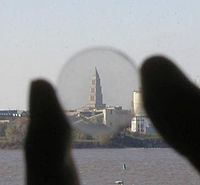
Photo from wikipedia
Abstract Wheel wear is a critical issue for grinding process optimization. This is why it receives so much attention both from Academia and industry. The development of new generations of… Click to show full abstract
Abstract Wheel wear is a critical issue for grinding process optimization. This is why it receives so much attention both from Academia and industry. The development of new generations of abrasive wheels requires improving the understanding of the mechanisms involved in the loss of abrasive capacity of the wheels. In the case of alumina wheels, which are largely used in many grinding operations, the development of microcrystalline sintered alumina grains is one of the most important innovations to emerge since the early 1980’s. In comparison with white fused alumina this grains are characterized by higher ductility and have approximately 5% more hardness. However, the mechanisms of occurrence of wear flats in these new abrasives are still to be fully understood. In this work, a novel approach to the study of the underlying phenomena that occur during the development of wear flats in microcrystalline sintered alumina grains is presented. Experimental results in terms of grinding forces, friction coefficient and surface analysis are presented and compared to those obtained with conventional white fused alumina. The value of wear flat area is as much as 25% higher in the case of microcrystalline sintered alumina grains. Results will be useful to prevent the development of grinding burns resulting from wear flat development in these new alumina wheels.
Journal Title: Journal of Manufacturing Processes
Year Published: 2018
Link to full text (if available)
Share on Social Media: Sign Up to like & get
recommendations!